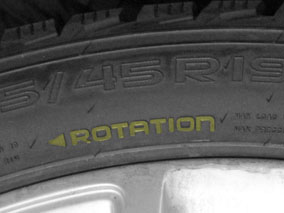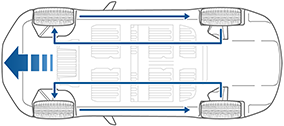Tire Rotation
Periodic tire rotation increases the service life of tires. Tesla recommends tire rotation at 6,250 mi (10,000 km) intervals.
Tire Rotation Patterns
The appropriate tire rotation pattern depends on the design of the tire. Check the sidewall to see if there is an arrow showing a specific rotation direction. If so, the tire is directional. When the vehicle is traveling forward, these tires must roll in the indicated direction.

Directional Tires
Non-Directional Tires - All Tires the Same Size
Most original equipment tires for Model S are non-directional and are the same size on the front and rear of the vehicle. To rotate non-directional tires that are the same size, move the rear wheels to the same positions on the front. Move the left front tire to the right rear, and the right front tire to the left rear.


